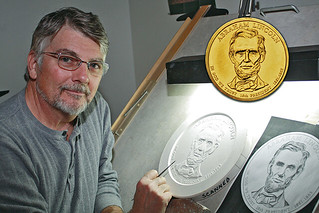
PREV ARTICLE
NEXT ARTICLE
FULL ISSUE
DON EVERHART ON ANALOG VS. DIGITAL ENGRAVINGRetired U.S. Mint engraver Don Everhart submitted these thoughts on analog and digital processes for creating coins and medals. Thanks! -Editor
The distinction, however lies with the ability of the artist making the initial model. In my time at the United States Mint I utilized both processes. We started using the digital process around 2009 I sculpted exclusively in clay and plaster. When I was finished with the model it went to a scan, and ultimately, the CNC process of reduction. The Janvier reduction pattern is circular, like the grooves on a vinyl record. The digital reductions were accomplished with a back and forth method, similar to how a TV reproduces images. The die cleaners at the Mint felt the digital reductions were easier to clean. Removing the reduction lines must be done in both processes. The biggest distinction, in my mind, however, was the ability of the artist in the initial sculpting process. I felt that the images that were sculpted digitally, on a computer did not have the same emotive power of the hand sculpted designs. They appeared to me to not have as much spontaneity. Of course, the responsibility is on the artist to make a convincing and competent sculpt from an existing design. That is not to say that in the hands of a master sculptor a level of beauty and perfection cannot be obtained using Freeform or Z Brush, or some other digital sculpting program. I have seen work from digital sculptors that is truly exceptional. And I have seen traditionally sculpted medals that were incompetent. I resisted the digital movement when it first came the the Mint, but after a while, I saw the benefits of it. For one thing, changes and edits to the final model are much quicker and more detailed than can be obtained using plaster models. One does not have to go through the whole process of casting and re-casting to fix a small imperfection. So it was a major time-saver when faced with the tight deadlines of a commercial mint. It also freed the sculptor from having to go through the process of creating lettering on the plaster model. I learned how to do lettering in plaster from my days at the Franklin Mint and my 24 year freelance career. Not having to go through the time consuming task of creating letterting in plaster gave me more time to work on and perfect my portrait, or whatever subject matter I was tasked to create. So, in conclusion, although I felt the Janvier reductions were fine, I also saw the advantages of sculpting the model in plaster, then finishing or editing the final digital model. To read the earlier E-Sylum article, see: Wayne Homren, Editor The Numismatic Bibliomania Society is a non-profit organization promoting numismatic literature. See our web site at coinbooks.org. To submit items for publication in The E-Sylum, write to the Editor at this address: whomren@gmail.com To subscribe go to: https://my.binhost.com/lists/listinfo/esylum All Rights Reserved. NBS Home Page Contact the NBS webmaster 
|
